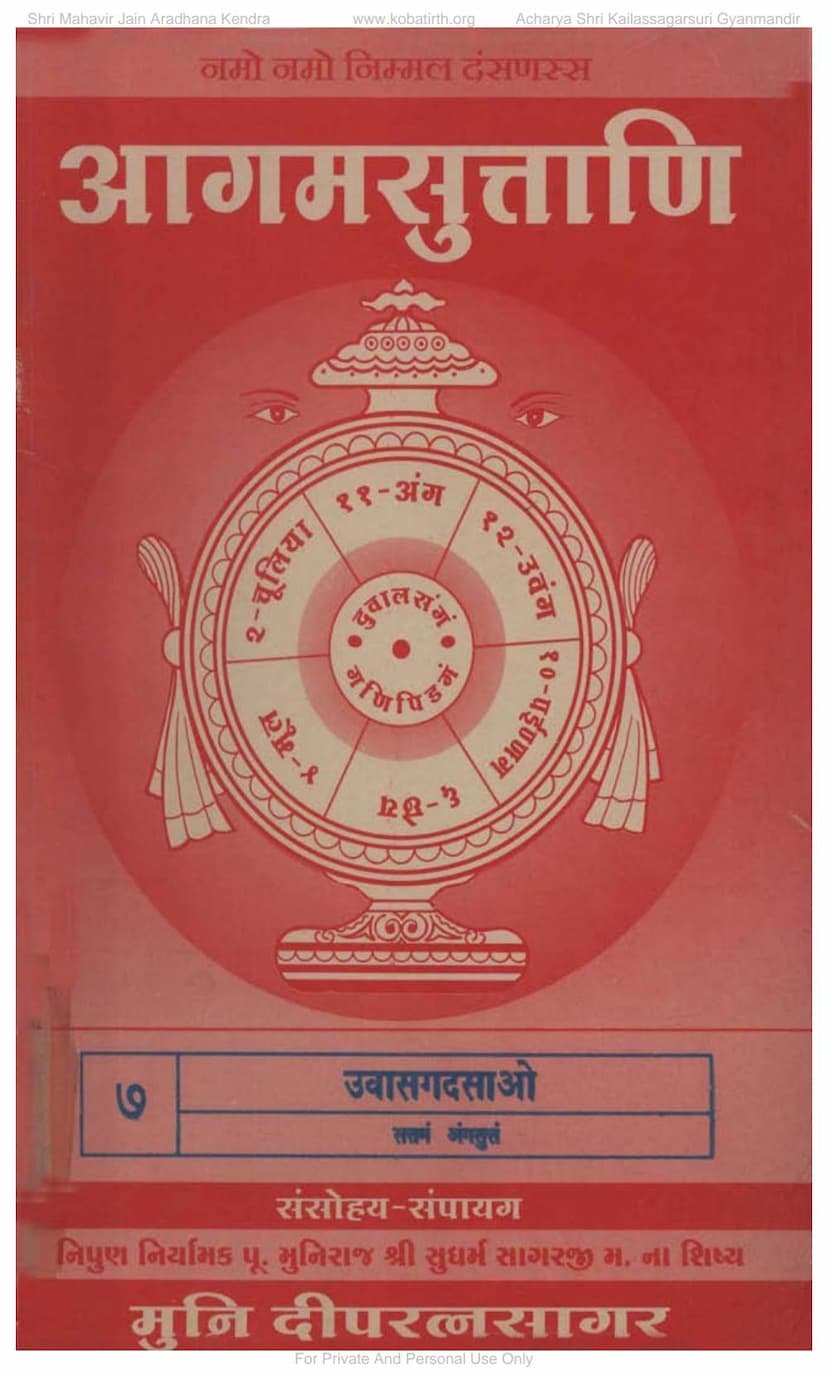Agam 07 Uvasagdasao Angsutt 07 Moolam
Added to library: September 1, 2025

Summary
This document is the Gujarati text of Uvasagadasao (The Lay Disciples' Chapter), which is the seventh Anga (limb) of the Agam Sutras in Jainism. It is part of the Agam Shrut Prakashan series, specifically Volume 7, Anga Sutra 7. The text is authored by Dipratnasagar and Deepratnasagar.
Here's a breakdown of the content based on the provided pages:
Overall Structure and Purpose:
- Agam Sutras: The text is identified as part of the Agam Sutras, which are the foundational scriptures of Jainism.
- Uvasagadasao: This specific Anga deals with the conduct and experiences of lay disciples (upasakas).
- Purpose: The text aims to guide and inspire followers on the Jain path through narratives and teachings.
Key Information from the Initial Pages (Pages 1-6):
- Title and Authorship: Clearly states the title "Uvasagadasao" and the authors Dipratnasagar and Deepratnasagar.
- Publisher: Agam Shrut Prakashan.
- Catalog Link: Provides a link to jainqq.org, indicating a source for Jain scriptures.
- Dedication and Salutations: Includes salutations to various Jain Acharyas, Munis, and spiritual guides, highlighting the reverence within the tradition.
- Financial Support: A significant portion of the early pages (Page 3 onwards) is dedicated to listing the numerous individuals and organizations who provided financial contributions for the publication of this Agam set. This reflects the communal effort involved in preserving and disseminating Jain scriptures. These contributors are often associated with specific Acharyas or spiritual events.
- Printing and Composition: Mentions the printing press (Navprabhat Printing Press, Ahmedabad) and composition details.
- Table of Contents/Structure: Page 6 provides an outline or index of the chapters or sections within the Uvasagadasao, listing them with numerical ranges:
- 1-17
- 18-26
- 27-29
- 30-31
- 32-34
- 35-38
- 39-45
- 46-54
- 55
- 56-72
- It also lists "Parisitth-nidansan" with similar numerical ranges, suggesting appendices or related content.
Content of the Uvasagadasao (Pages 7 onwards):
The subsequent pages detail the actual content of the Uvasagadasao, beginning with the first chapter ("Aanande").
-
Chapter 1: Aanande (Ananda)
- Setting: The narrative begins in the city of Champa, near the Punya-bhadra Chaitya.
- Key Figures: The chapter introduces Ananda, a wealthy householder, and his wife, Shivananda. It also mentions Lord Mahavir and his chief disciple, Acharya Sudharmaswami, and his disciple, Ananta-jambu.
- Ananda's Virtues: Ananda is described as wealthy, prosperous, influential, and virtuous. He is presented as a pillar of his family and community.
- Encounter with Lord Mahavir: The text describes Ananda's respectful approach and deep devotion upon meeting Lord Mahavir.
- Ananda's Vow: Ananda takes vows of lay discipleship (Pancha-nuvvaiyam, Saptasikhavaiyam, Dwadasa-vidha Savadhamma). The text details the specific restrictions he undertakes, covering various aspects of his life and possessions.
- Ananda's Spiritual Progress: Ananda diligently follows his vows and progresses through the eleven stages of lay discipleship (Upasaka-pradima).
- Ananda's Death and Rebirth: The narrative describes Ananda's spiritual attainment, death, and rebirth in the Swargaloka (heavenly realm).
- Acharya Gautama's Inquiry: Acharya Gautama inquires about Ananda's understanding of soul and karma, and his subsequent spiritual achievements.
- Ananda's Heavenly Life: The text describes Ananda's life as a celestial being.
-
Subsequent Chapters (Chapters 2 onwards): The text then moves on to introduce other lay disciples and their spiritual journeys, likely following a similar pattern of:
- Introduction of the disciple and their background.
- Encounter with Lord Mahavir.
- Taking of vows and adherence to the Jain principles.
- Tests or challenges faced.
- Spiritual progress and eventual attainment.
The names of other disciples mentioned in the table of contents and early chapter listings include:
- Chapter 2: Kamadeva (Kamadeva)
- Chapter 3: Chulani-pita (Chulani's Father)
- Chapter 4: Suradeva (Suradeva)
- Chapter 5: Chulla-sataka (Chulla-sataka)
- Chapter 6: Kundakolika (Kundakolika)
- Chapter 7: Saddalaputta (Saddalaputta)
- Chapter 8: Mahasataka (Mahasataka)
- Chapter 9: Nandini-putra (Nandini's Son)
- Chapter 10: Leiyapita (Leiyapita)
Key Themes and Principles:
- Importance of Lay Discipleship: The Uvasagadasao emphasizes the significance of lay followers in Jainism and their role in spiritual progress.
- Conduct and Ethics: It details the ethical guidelines (vows) that lay disciples should follow in their daily lives.
- Devotion and Respect: The text highlights the importance of devotion and respect towards the Tirthankaras (Jinas) and the monastic order.
- Karma and Rebirth: The narratives implicitly or explicitly illustrate the principles of karma and the cycle of birth and rebirth.
- Spiritual Discipline: The stories demonstrate the transformative power of spiritual discipline, austerities, and adherence to the teachings of the Jinas.
- Overcoming Obstacles: The disciples often face challenges, temptations, or worldly attachments, which they overcome through their faith and commitment.
In essence, the Uvasagadasao serves as a practical guide and an inspirational source for Jain lay followers, illustrating how to live a righteous and spiritually progressive life while engaged in worldly affairs.